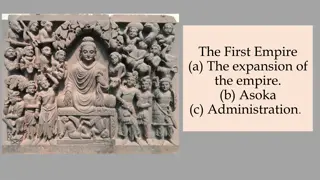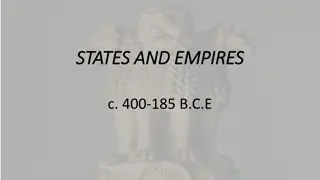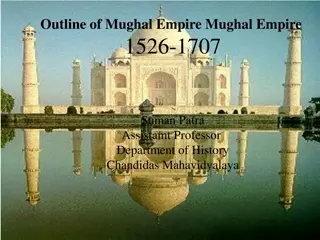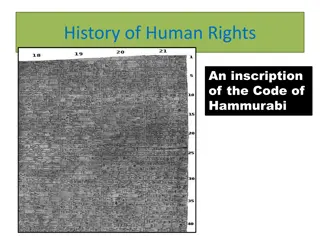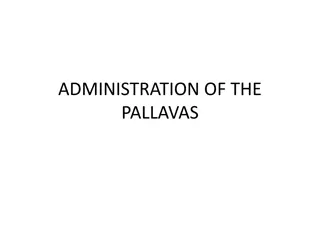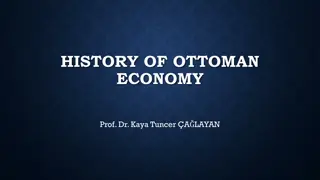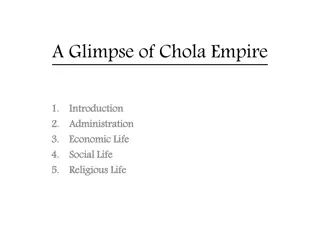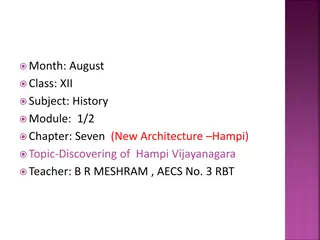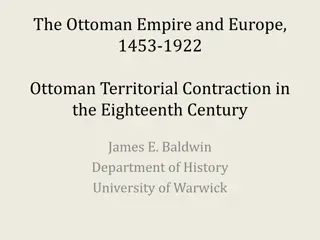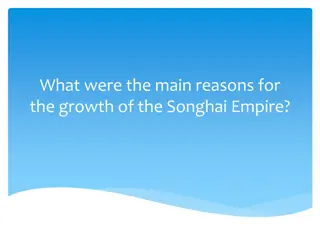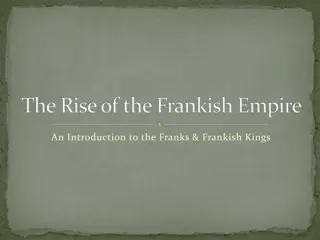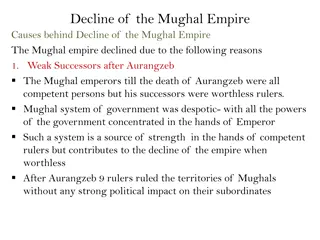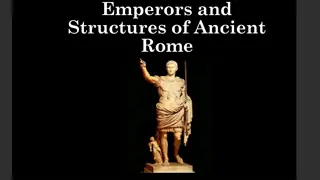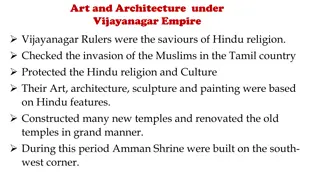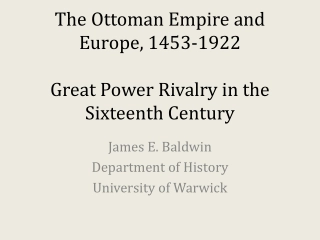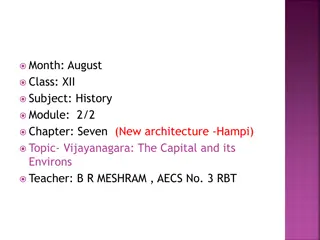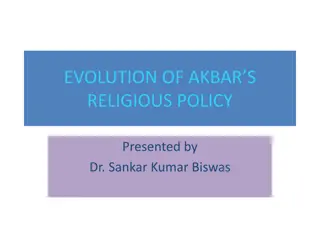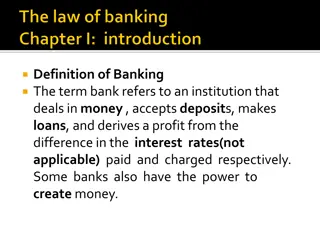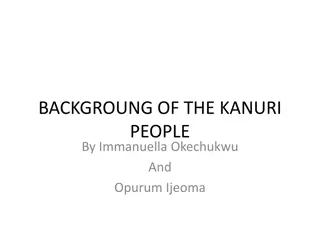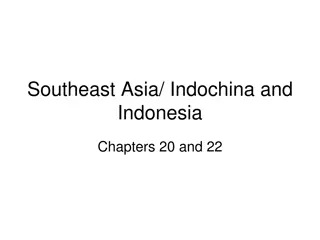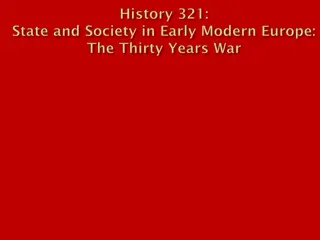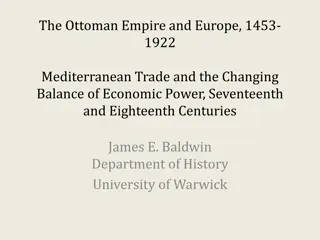Overview of Mauryan Empire: Chandragupta, Bindusara, and Ashoka
Mauryan Empire, established by the Mauryas, was the first major empire in India, encompassing a vast territory and surpassing previous dynasties in land control. Chandragupta Maurya, Bindusara, and Ashoka were key emperors who shaped the empire's history. Chandragupta, supported by Chanakya, conquered Magadha and expanded his rule in northern India. Bindusara continued the expansion, defeating rulers of 16 kingdoms. Ashoka, known as Ashoka the Great, transformed from a ruthless emperor to a compassionate ruler after the Kalinga war. His Dhamma policy promoted religious tolerance and harmony. The empire's history is documented in texts like "Indika" and "Arthashastra."
Uploaded on Jul 31, 2024 | 0 Views
Download Presentation

Please find below an Image/Link to download the presentation.
The content on the website is provided AS IS for your information and personal use only. It may not be sold, licensed, or shared on other websites without obtaining consent from the author. Download presentation by click this link. If you encounter any issues during the download, it is possible that the publisher has removed the file from their server.
E N D
Presentation Transcript
Introduction Mauryas established the first ever empire in India Larger than kingdom and spread over a vast area Controlled more land than previous dynasty
Sources of Information Two books Indika by Magesthenes Indika tells about the political social and economic Condition during that period Ambassador of Seleucus Nicator and Lived in court of Chandragupta Arthashastra by Kautilya It deals with how to govern an empire and describes the administration of the Mauryas
Chandragupta Maurya (321 297 BCE) Bindusara (297 273 BCE) Ashoka (273 232 BCE)
Chandragupta Maurya (321 297 BCE) First ruler of Dynasty and last Nanda ruler in 321 BCE Supported by his minister Chanakya known as Kautilya or Vishnugupta First conquered Magadha Defeated Seleucus Nicator- General of the Greek King Alexander Strengthen his control over other parts of northern India
Bindusara (297 273 BCE) Also called Bindusara Maurya, Greek Amitrochates, born 320 BCE died 272 BCE Second Mauryan emperor , who ascended the throne about 297 BCE. Greek sources refer to him as Amitrochates, Greek for the Sanskrit amitraghata refers to destroyer of foes. He defeated rulers of 16 kingdoms and added their land to his empire. Under him the Mauryan empire spread across the whole Indian subcontinent.
Ashoka 273-232 BCE Popularly known as Ashoka the Great, was the 3rd Mauryan Emperor of the Mauryan Empire of India during 268 to 232 BCE. The war to occupy Kalinga was considered the bloodiest and most lethal that Emperor Ashoka had ever waged. The massive loss of lives and damage left him shattered and regretful, which ultimately caused him to transform from a fierce and vengeful ruler to a peaceful and benevolent emperor. He is said to have constructed approximately 84,000 stupas and pillars across his empire during his lifetime.
Ashokas Dhamma Ashoka pleaded for tolerance of different religious sects in an attempt to create a sense of harmony. The policy of Dhamma also laid stress on non-violence, which was to be practiced by giving up war and conquests and also as a restraint on the killing of animals. The principles of Dhamma were formulated to be acceptable to people belonging to different communities and following any religion.
Principles of dhamma Ashoka wanted his subjects to follow such a Dhamma that maybe based on the unifying principles of all major religions of the world. Ashoka's Dhamma has the following salient points: 1. Respect to elders and love to children. 2. Ahimsa or non-violence. 3. Good deeds would give happiness to man in the next birth. 4. He taught people to respect all religions. 5. He disapproved empty rituals.
Spread of dhamma He appointed Dhamma mahamattas, who went from place to place teaching people about Dhamma. Ashoka also used inscribed rock pillars to spread his message of Dhamma. He also sent messengers to spread the message of Dhamma Ashoka's dhamma was neither a new religion nor a new political philosophy. Rather, it was a way of life, a code of conduct and a set of principles to be adopted and practiced by the people at large. other countries like Syria, Egypt, Greece and Srilanka.
Administration Mauryan administration was highly centralized. The Emperor was the supreme power and source of all authority. He was assisted by a Council of Ministers. It was called 'Mantriparishad'. The ministers were called Mantris. The council was headed by mantriparishad-adhyakshya akin to the Prime Minister of today. Tirthas: the Highest category of officials in the administration. There were 18 Tirthas. Adhyakshya: Ranked next only to Tirthas. There were 20 Adhyakshyas. They had economic and military functions. Mahamattas: Higher ranking officials. Amatyas: High ranking officials almost like present-day secretaries. They had administrative and judicial roles. The Adhyakshyas were formed into a secretariat, which was divided into many departments.


